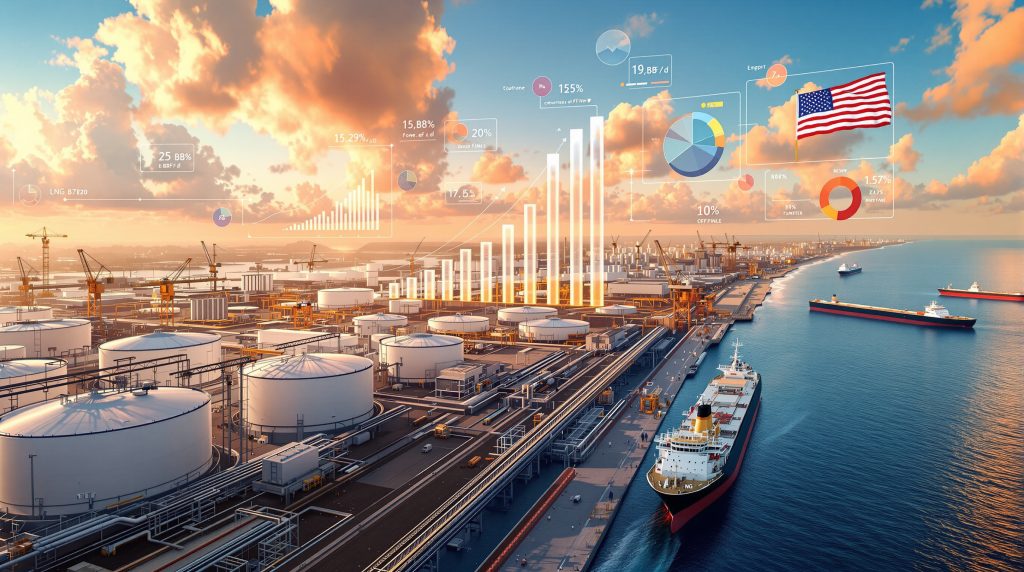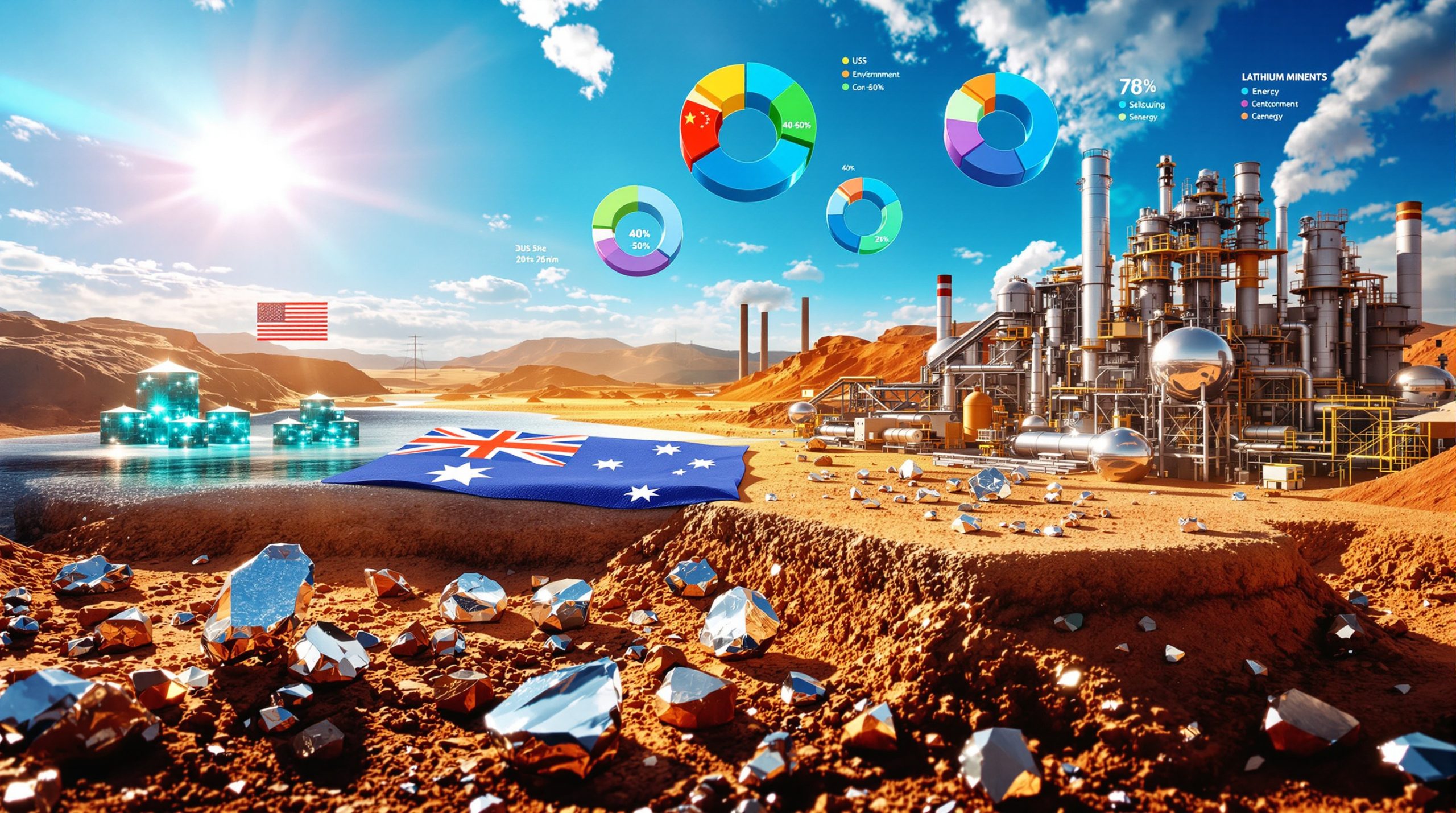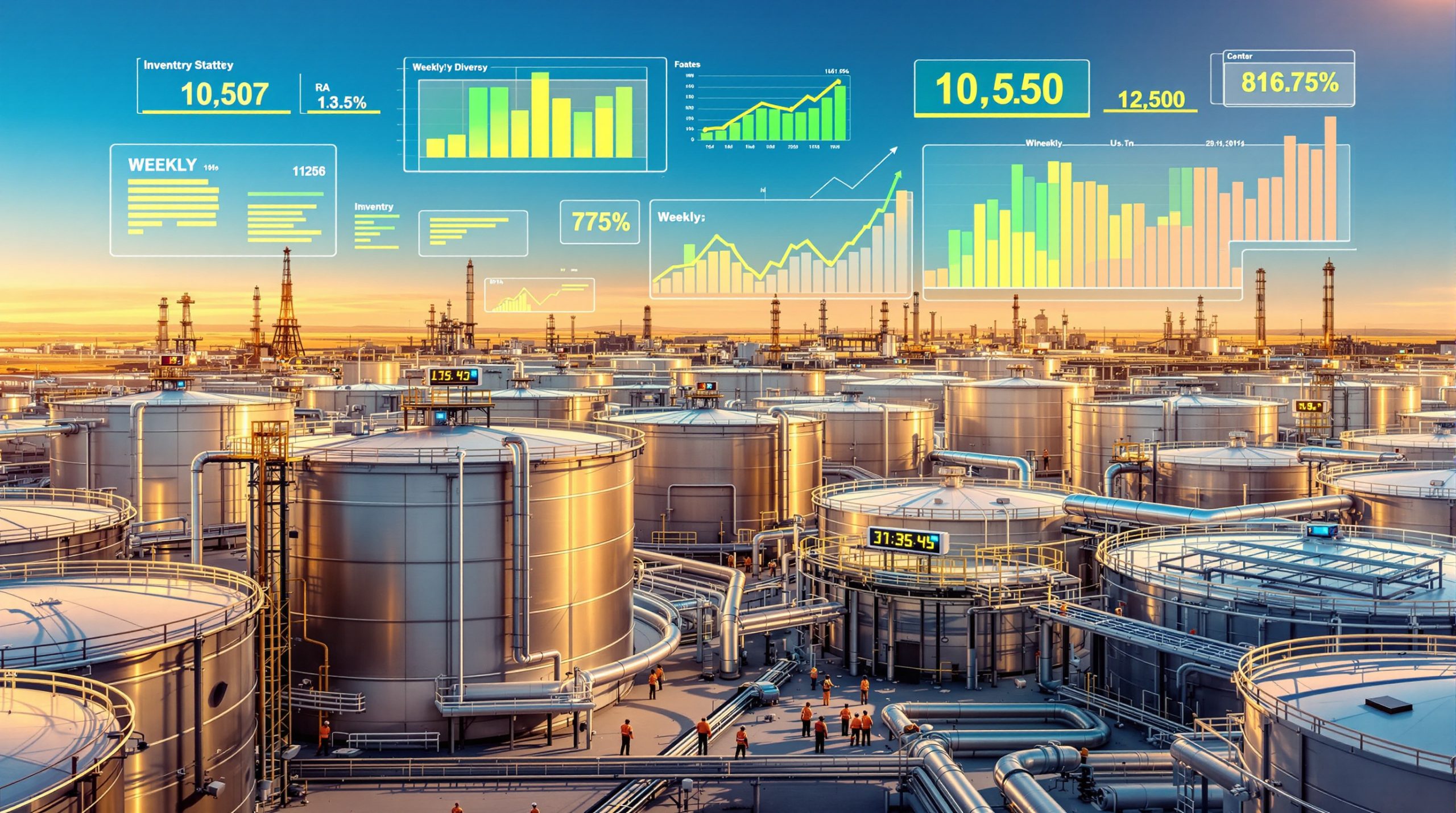Understanding America's Natural Gas Export Transformation
The United States has undergone a remarkable transformation in its energy sector, evolving from a net importer of natural gas to becoming the world's dominant LNG exporter. This shift represents one of the most significant changes in global energy markets over the past decade, fundamentally altering both domestic and international energy dynamics.
Current U.S. LNG export capacity expansion has positioned America as the cornerstone of global energy security, with facilities now operating at unprecedented scales. The infrastructure supporting this growth spans multiple regions, with the Gulf Coast serving as the primary hub for these operations. Furthermore, this expansion is closely linked to broader energy market developments and policy shifts that continue to shape the sector.
Current Export Infrastructure Landscape
American natural gas export facilities have reached a combined capacity exceeding 15 billion cubic feet daily, representing approximately 40% of global LNG trade flows. This infrastructure foundation has transformed the United States into the world's leading supplier of liquefied natural gas, fundamentally reshaping international energy markets.
The performance metrics demonstrate the scale of this transformation:
• Daily export capacity: 15.4 Bcf/d as of 2025
• Global market share: Approximately 20% of worldwide LNG exports
• Primary export regions: Gulf Coast terminals handling 85% of total capacity
• Average utilization rates: 92-95% across major facilities
These facilities operate with remarkable efficiency, maintaining high utilization rates that reflect both strong global demand and operational excellence. The concentration of capacity along the Gulf Coast provides strategic advantages in terms of feedgas supply and shipping accessibility to both Atlantic and Pacific markets.
The Path to Doubled Capacity by 2029
American energy companies have committed unprecedented resources to infrastructure expansion, with projects totaling nearly 14 billion cubic feet per day of additional capacity scheduled for completion before 2030. This ambitious timeline represents one of the largest industrial buildouts in recent history.
According to the International Energy Agency, this surge in production will significantly reshape global gas markets over the coming decade.
Major Construction Projects Currently Underway
The expansion encompasses multiple large-scale developments across strategic locations. Gulf Coast Expansion Hub projects include several significant additions: Plaquemines LNG Phase 2 will contribute 1.8 Bcf/d with operational status expected in 2025, while Corpus Christi Stage 3 adds 1.4 Bcf/d ramping through 2026. Golden Pass LNG represents a major milestone with 2.1 Bcf/d capacity starting in 2025, and Port Arthur Phase 1 contributes another 1.6 Bcf/d currently under construction.
Western Gulf Developments further expand this capacity base. Rio Grande LNG will provide 2.1 Bcf/d capacity, complemented by Woodside Louisiana facility's 2.2 Bcf/d contribution and CP2 Phase 1's 2.0 Bcf/d expansion.
Capacity Addition Timeline
| Year | New Capacity (Bcf/d) | Cumulative Total (Bcf/d) |
|---|---|---|
| 2025 | 3.2 | 18.6 |
| 2026 | 4.1 | 22.7 |
| 2027 | 3.8 | 26.5 |
| 2028 | 2.8 | 29.3 |
This expansion timeline reflects careful coordination between project developers, with staggered completions designed to optimise market entry and operational efficiency. The cumulative effect will nearly double American LNG export capacity within a five-year period.
Global Demand Drivers Fueling Growth
International appetite for American natural gas continues expanding across multiple continents, driven by energy transition policies and geopolitical supply diversification strategies. This demand growth creates sustained market opportunities for U.S. LNG export capacity expansion.
Industry analysts suggest that the U.S. LNG boom could reshape energy markets in unprecedented ways, particularly as export capacity continues to surge.
Primary Import Markets
European Union Requirements have intensified following geopolitical developments. Annual import volumes range from 45-50 million tonnes, with replacement demand for Russian pipeline gas reaching 35 billion cubic metres annually. Long-term contract commitments typically span 15-20 year terms, providing revenue stability for American exporters.
Asian Pacific Consumption represents the largest market segment globally. Japan maintains annual imports of 70 million tonnes, while South Korea requires 45 million tonnes annually. China's consumption has reached 75 million tonnes with growth rates of 8% yearly, and India's market has expanded to 35 million tonnes with rapid growth trajectories.
Emerging Market Penetration creates additional growth opportunities. Southeast Asian nations are increasing imports by 12% annually, whilst Latin American countries transition from coal to gas-fired generation. African markets are simultaneously developing LNG-to-power infrastructure, creating new demand centres.
Infrastructure Challenges and Constraints
Despite ambitious expansion plans, several bottlenecks threaten to constrain the pace of capacity additions and operational efficiency. These challenges require coordinated solutions across multiple infrastructure systems.
Pipeline Connectivity Constraints
Feedgas Supply Networks face capacity limitations that could restrict export growth. Permian Basin pipeline capacity approaches its 15 Bcf/d limits, while Appalachian takeaway capacity requires expansion beyond current 8 Bcf/d levels. Gulf Coast interconnection projects need approximately $12 billion in investment to support projected export volumes.
Transportation Infrastructure presents additional challenges. Marine terminal depth limitations at existing ports constrain vessel sizes and operational efficiency. Vessel scheduling conflicts during peak demand periods create logistical complications, while storage capacity constraints during maintenance windows affect operational flexibility.
Regulatory and Environmental Considerations
Permitting processes create timeline uncertainties for new projects. Federal environmental reviews typically require 18-24 months, with state-level approvals adding 12-18 months. Local community engagement requirements and wildlife protection compliance measures further complicate development schedules.
Domestic Energy Cost Implications
Increased overseas shipments create direct competition between foreign buyers and American consumers, fundamentally altering domestic natural gas pricing dynamics. This competition mechanism links domestic prices increasingly to international market conditions. However, the US natural gas forecast suggests complex price interactions ahead.
Price Impact Analysis
Historical price relationships demonstrate this transformation clearly. Pre-2016 domestic prices typically ranged from $2-4 per million British thermal units (MMBtu), while current pricing ranges from $3.50-5.50 per MMBtu. International price premiums now consistently exceed domestic prices by 40-60%.
Consumer impact projections indicate significant cost increases across sectors:
| Sector | Current Cost Impact | Projected 2029 Impact |
|---|---|---|
| Residential heating | +15-25% | +30-45% |
| Industrial processes | +20-30% | +35-50% |
| Power generation | +12-18% | +25-35% |
| Chemical manufacturing | +25-35% | +40-60% |
Regional Variations
High-impact areas face particular vulnerability to price increases. Northeast heating markets show greatest exposure to price spikes due to limited pipeline capacity and seasonal demand patterns. Industrial corridors experience manufacturing cost pressures that affect competitiveness, whilst power generation regions transmit electricity price effects to end consumers.
Technology's Role in Capacity Optimisation
Advanced liquefaction technologies and operational improvements enable higher throughput rates whilst reducing per-unit production costs. These innovations support U.S. LNG export capacity expansion efficiency and competitiveness.
Next-Generation Systems
Efficiency improvements across multiple technology areas drive operational excellence. Modular construction techniques reduce installation time by 20%, whilst advanced refrigeration cycles achieve 15% energy savings. Digital monitoring systems maintain 95% uptime reliability, and predictive maintenance protocols reduce costs by 30%.
Capacity Enhancement Technologies include floating LNG platforms that enable rapid deployment, small-scale modular units supporting distributed production networks, and hybrid renewable integration incorporating solar-powered auxiliary systems.
Geopolitical Factors Shaping Export Strategy
International tensions and energy security concerns drive long-term contracting patterns and infrastructure investment priorities. These factors increasingly influence both commercial and policy decisions surrounding American LNG exports. The recent Alaska oil & gas policy shift demonstrates how political considerations affect energy infrastructure development.
Strategic Partnerships
Allied Nation Agreements include NATO member preferential pricing arrangements, Indo-Pacific partnership supply guarantees, and democratic ally energy security commitments. These relationships provide market stability whilst supporting broader foreign policy objectives.
Supply Chain Resilience Measures incorporate multiple risk mitigation strategies. These include multiple source redundancy for critical components, domestic manufacturing requirements for key equipment, and strategic petroleum reserve coordination with LNG exports.
Environmental Considerations and Regulations
Climate policy objectives and environmental regulations influence project development timelines and operational parameters. These factors create both challenges and opportunities for industry participants.
Carbon Management Initiatives
Emission reduction initiatives demonstrate industry commitment to environmental stewardship. Methane leak detection systems achieve 99% capture efficiency, whilst carbon capture integration covers 15% of new projects. Renewable energy powered facilities incorporate solar and wind integration, and electrification of compression equipment reduces emissions.
Regulatory Compliance Framework includes EPA methane standards requiring quarterly monitoring, state-level environmental assessments conducting comprehensive impact studies, and international carbon border adjustments creating future trade implications.
Industry Leaders and Market Participants
Major energy corporations and specialised LNG developers drive infrastructure expansion through substantial capital investments and operational expertise. These companies shape market development and competitive dynamics.
Leading Companies
Integrated Oil Companies include Chevron developing Golden Pass LNG, ExxonMobil pursuing Gulf Coast expansion projects, and ConocoPhillips establishing feedgas supply agreements.
Specialised LNG Developers feature Cheniere Energy maintaining market-leading export capacity, Sempra Infrastructure managing multi-project development portfolios, and NextDecade constructing Rio Grande LNG.
International Partnerships involve Shell participating in joint ventures, TotalEnergies providing long-term offtake commitments, and Japanese trading companies making equity investments.
Economic Benefits and Multiplier Effects
LNG export expansion generates significant economic activity across multiple sectors whilst creating high-paying employment opportunities. These benefits extend beyond direct project impacts to broader economic development.
Employment and Revenue Impact
Direct economic benefits include substantial job creation during both construction and operational phases. Construction phases generate approximately 45,000 jobs per major project, whilst operational employment provides 8,000 permanent positions with 3:1 multiplier effects and average wage premiums 40% above regional averages.
Tax Revenue Generation contributes significantly to government finances. Federal tax contributions reach $2.8 billion annually, whilst state and local revenues generate $1.2 billion per year. Property tax assessments provide $450 million regional impact.
Supply Chain Benefits
Broader economic multiplier effects extend throughout related industries. Steel and equipment manufacturing experiences $8 billion annual demand, transportation services expand rail and trucking capacity, professional services grow in engineering and construction, and port and logistics infrastructure requires capacity upgrades.
Global Competitive Positioning
American LNG export growth occurs within a competitive international landscape where multiple nations seek market share expansion. Understanding this competitive environment helps assess long-term market positioning.
International Capacity Rankings
Global capacity standings as of 2025 demonstrate American leadership:
| Country | Export Capacity (Bcf/d) | Market Share (%) |
|---|---|---|
| United States | 15.4 | 28 |
| Australia | 11.2 | 20 |
| Qatar | 10.8 | 19 |
| Russia | 4.2 | 8 |
| Malaysia | 3.6 | 7 |
Competitive Advantages
American Strengths include abundant domestic gas resources providing 100+ year supply reserves, advanced technology deployment in cutting-edge facilities, flexible contract structures enabling spot market participation, and geographic advantages providing both Atlantic and Pacific access.
Strategic Market Positioning enables premium pricing for reliable supply with 5-10% price premiums, long-term partnership development through 15-20 year agreements, and emergency supply capabilities coordinated with strategic reserve systems.
Market Psychology and Investment Dynamics
Understanding market psychology becomes crucial as U.S. LNG export capacity expansion creates new competitive dynamics. Industry participants must navigate complex relationships between domestic consumption, export opportunities, and pricing mechanisms. These dynamics intersect with broader economic considerations, including the US economy and tariffs debate and potential US-China trade war impacts.
Investment strategies increasingly focus on supply chain integration and operational efficiency improvements. Companies prioritise projects with multiple competitive advantages, including feedgas supply security, optimal geographic positioning, and advanced technology integration.
Future Outlook and Considerations
The trajectory of American LNG exports faces several critical considerations that will shape industry development. Production sustainability represents a key concern as independent analysis suggests that domestic natural gas production may plateau and decline in the not-too-distant future. Moreover, recent oil price rally insights suggest complex interactions between energy commodities and trade policies.
This potential production constraint could create a double squeeze on natural gas supplies as LNG exports continue rising whilst domestic production faces limitations. Such dynamics would intensify competition between export markets and domestic consumers, potentially creating political pressure for policy interventions.
The success of U.S. LNG export capacity expansion ultimately depends on balancing multiple competing interests: maximising export revenues, maintaining domestic energy affordability, supporting economic development, and addressing environmental concerns. How industry and policymakers navigate these competing priorities will determine the long-term sustainability of America's position as the world's leading LNG exporter.
Disclaimer: This analysis is based on current industry trends and available data. Energy markets are subject to significant volatility, and future developments may differ from projections presented. Readers should conduct their own research and consult with qualified professionals before making investment or policy decisions related to energy markets.
Looking to capitalise on America's energy transformation?
Discovery Alert's proprietary Discovery IQ model delivers real-time notifications on significant ASX mineral discoveries, including energy-related commodities that could benefit from shifting global trade dynamics. Visit Discovery Alert's discoveries page to explore historic examples of major mineral finds that generated substantial returns, then begin your 30-day free trial to position yourself ahead of the market.




